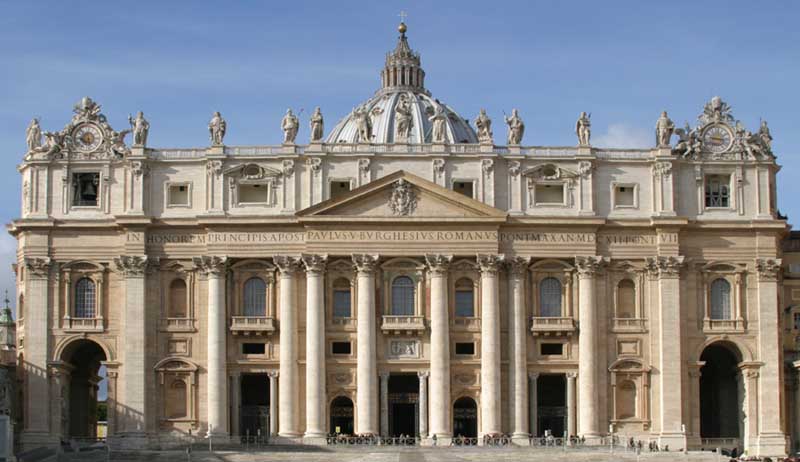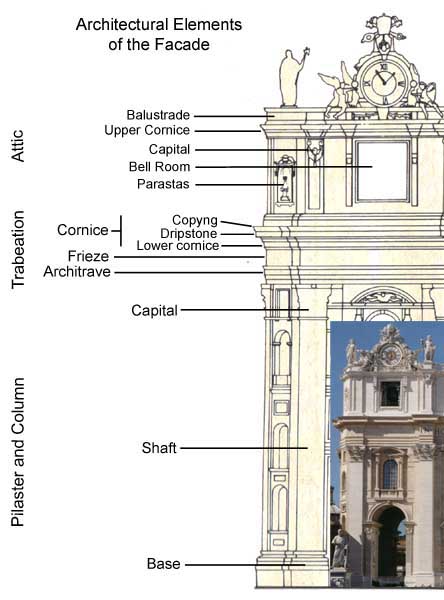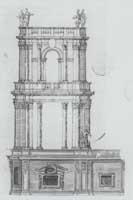Designed by Carlo Maderno
(1608-1614) The inscription
(1m letters) states:
"Paul V Borghese, Roman, Pontiff, in 1612, the seventh of his pontificate, [built] in honour of
the Prince of Apostles |
 |
Select Area
for Photos |

St Thaddeus,
also known as Jude Thaddeus, was one of
the Twelve Apostles, and the brother of
St James the Less. One of the canonical
letters is atttributed to him. He is the
patron saint of desperate or hopeless
cases. On the Facade statue he is
holding a halberd. His relics are here
in the basilica, under the
Altar of St Joseph in the Left
Transept.
St Matthew,
or Levi, was a tax-collector at
Capernaum before being called as an
apostle, and is the author of the first
gospel in the New Testament. The gospels
provide the only trustworthy data
concerning him. His attribute is a
winged man (not an angel), and he may be
depicted holding money. On the Facade,
his statue holds a sword and a book.
St Philip
was from Bethsaida in Galilee. He
is listed as fifth among the Twelve
Apostles and is mentioned three times as
a confidant of Christ in St John's
gospel. His attributes are a basket of
loaves and a cross, sometimes T-shaped.
His Facade statue holds a cross.
St
Thomas, one of the Twelve
Apostles, is surnamed 'Didymus', meaning
'the twin'. All that is known for
certain about him is in the gospels,
where he chiefly features in the episode
concerning his unbelief and subsequent
profession of faith in Christ's
resurrection. Hence, he is often
referred to as 'Doubting Thomas'. An ancient tradition
has him as a missionary to Kerala in
south India and martyred there. His
named was attached to apocryphal
writings of 2nd-4th centuries, such as
the Gospel of Thomas. His attribute is a
lance, which he holds on the Facade
statue.
St James the
Great was a son of Zebedee
and Salome. He was the brother of St
John the Evangelist and called with him
to be one of the Twelve Apostles by
Christ. He was quickly martyred after
the Resurrectrion by order of King Herod
Agrippa (Acts 12:2), the only apostle
whose martyrdom is mentioned in the New
Testament. A 9th century legend makes
him apostle of Spain and specifies
Compostela as the place where his body
is enshrined. He is the patron saint of
Spain, and his attribute is a scallop
shell.
|
St
John the Baptist was the
last of the prophets and the forerunner
of Christ. He is described in the
four Gospels, where he is presented as
modelled on Elijah, and Jesus Christ's
cousin. John used baptism as the central
sacrament of his messianic movement, and
baptized Jesus. John was sentenced
to death and beheaded by Herod Antipas,
after John rebuked him for divorcing his
wife Phasaelis, and unlawfully taking
Herodias, the wife of his brother
Philip. John is often depicted as an
ascetic wearing a camel hair, with a
staff and a lamb. On the facade, the
scroll on his staff has the inscription,
Ecce Agnus Dei.
Christ the Redeemer
Redeemer is one of the titles of Christ.
It refers to the saving significance of
his death. With the facade statue,
Christ is giving a blessing and standing
beside his cross. The top section of
this cross is made of copper. Between
1985 and 1987, the Knights of Columbus
funded the refurbishment of the entire
façade of St. Peter’s Basilica. In
gratitude, Pope John Paul II presented
the Knights with the copper cross which
had been held in the arms of the statue
of the Christ atop the facade since
1614. The cross is now on display in the
Knights of Columbus Museum in New Haven,
Conn.
St Andrew, the elder
brother of St Peter was the first called
of the Apostles, and features in the
Gospels. Patristic authors preserved the
traditions that he evangelized Scythis
and the heartland of northern Greece,
being martyred at Patras. The tradition
that he was executed on a diagonal cross
came later. Thomas Palaeologus the son of the Byzantine Emperor fled Patras for exile in Italy, bringing what was purported to be the skull of St Andrew. He gave the relic to Pope Pius II. and it was enshrined in one of the four central piers of St. Peter's.
In September 1964, Pope Paul VI, as a gesture of goodwill toward the Greek Orthodox Church, returned the relics of St Andrew to Patras.
Note: The statue of
St Peter is not on the facade,
because it is in the Square below, as is
the statue of
St Paul
|
St John the Evangelist
was the son of Zebedee and brother of St
James the Great. He was a
fisherman from Galilee until called to
be an Apostle. The author of the
fourth gospel, he is usually identified
with 'the Disciple that Jesus loved'. One
tradition holds that he was exiled from
Rome to the island of Patmos, where he
wrote the Book of Revelation. It is
thought that he was the only Apostle to
live to an old age, and not be killed
for the faith. His attribute is an
eagle, which is shown on his Facade
statue.
St James the Less
was one of the Twelve, and after the
Resurrection became the first bishop of
Jerusalem. He is mentioned by Eusebius,
and is the putative author of one of the
canonical letters. According to
tradition he was martyred at Jerusalem
by being thrown from a pinnacle of the
temple, stoned and then finally killed
with a fuller's club. This club became
his attribute, and is shown on the
Facade statue.
St
Bartholomew is listed among
the Twelve in the synoptic gospels and
is identified with the Nathaniel in the
first chapter of the gospel of St John.
Eusebius states that he was in 'India'
and the Roman tradition has him being
martyred in Armenia. Legend has it that
he was skinned alive, and he is often
depicted holding his flayed skin.
His atttribute is the flaying-knife,
shown on the Facade statue.
St
Simon is referred to in the
New Testament in the lists of the
apostles with the surname 'Cananean'
meaning 'Zealot'. Traditions concerning
his career after the Resurrection are
conflicting, and he is one of the most
obscure among the Apostles. He has
various attributes: a fish, a boat, an
oar or a saw. He is depicted with
the saw on the Facade.
St Matthias was chosen by
lot to take the place of Judas Iscariot
among the apostles. His selection
was not made by Jesus, and it was before
the descent of the Holy Spirit upon the
early Church members. The Apostles
cast lots, and the lot fell to Matthias
who was numbered among the Twelve.
His relics were allegedly removed by St
Helen from Jerusalem to what is now St
Matthias Abbey at Trier, Germany. He is
depicted as an elderly man holding a
halberd on the Facade statue.
|
On February 10, 1608 the first stone of the
Facade was laid and on July 21, 1612 most of the
work was completed. It took another two years for the ornamentation,
and the basilica was finally consecrated by
Urban VIII on November 18, 1926.
From the central
balcony, called the Loggia of the Blessings,
the new pope is announced with "Habemus Papum",
and gives the Urbi et Orbi blessing (to the city
and to the world) upon his election and at
Christmas and Easter.
The relief under the balcony, by Buonvicino, represents
Christ giving
the keys to St. Peter. The facade is 114.69 metres (376.3 ft) wide and
45.55 metres (149.4 ft) high and is built of travertine.
Above the basic
structure is an attic, with eight square windows decorated with
small pilasters, surmounted by a balustrade and 13 statues in travertine.
The statues on the balustrade represent Christ the Redeemer (19
feet high), St. John the Baptist and 11 Apostles. St. Mathias is
included because he is associated with the other "Eleven"
in bearing witness to Christ's Resurrection. St Peter is not
included because his statue is below in the
Square.
|

Source:
Works On The Facade of St. Peter's Basilica
|
When
Carlo Maderno started to build the facade, he was bound to
the already existing Michelangelo's wings. He just put the
attic all around the building, as planned by Michelangelo.
That creation looks mighty and dynamic along the west side
of the Basilica but is disharmonious in the facade. For this
reason, at the far sides of the facade, Maderno planned two
bell towers which lightened and soared the building. In 1621,
at the death of Paul V, the ground subsided and the building
of the two bell towers had to be stopped.
In 1646,
Bernini tried to erect the bell towers again, but had to demolish
the left-hand side bell tower because of cracks in the facade.
Only the bases of the bell towers remain, two archways at
the sides of the facade that seem to form part of it while
they should have been separated. This was remedied in 1790
by the installation of two clocks designed by Giuseppe Valadier.
The eight
gigantic columns of the facade are almost 10ft wide and 90
feet high.
The restoration
of the facade and the 13 statues, begun in April 1985, was
concluded on November 30, 1986. The original copper cross
(1613) in the arms of the statue of the Redeemer, which was
replaced by a new one during the work, was given to the Knights
of Columbus in recognition of their support for the restoration.
 |
Drawing showing Bernini's Bell Tower
Anonymous
c.1645 |
|
|
Sources:
Dom Basil Watkins, OSB (ed.), The Book
of Saints, 2002
A. Sperandino, Works On The Facade of
St Peter's Basilica, 1989
|
|
|

